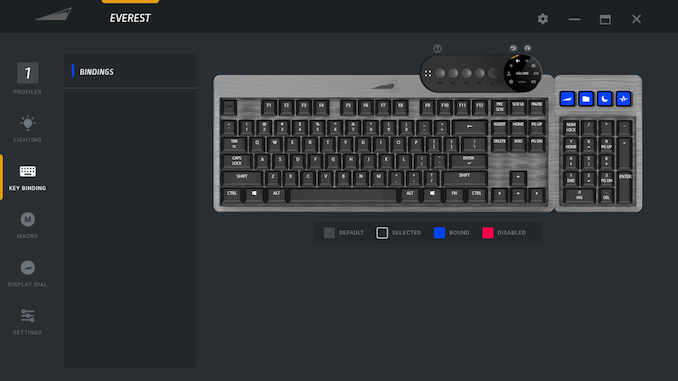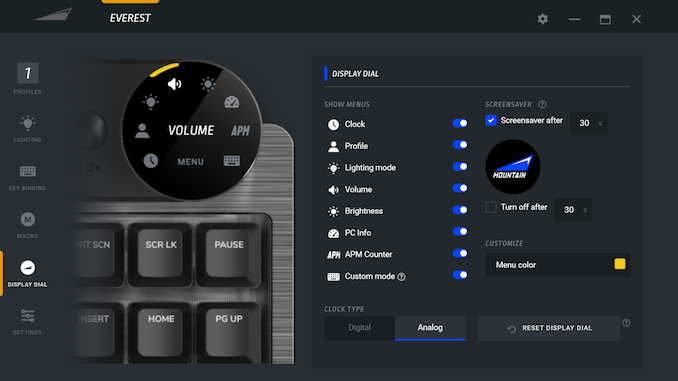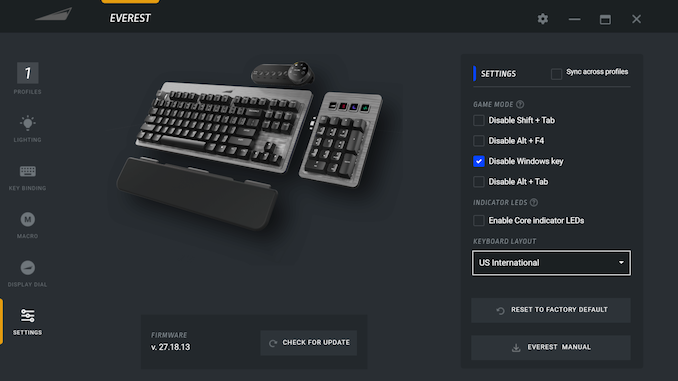The Mountain Everest Max Mechanical Keyboard Review: Reaching New Heights in Build Quality
by E. Fylladitakis on November 17, 2021 10:45 AM EST- Posted in
- Peripherals
- Cherry MX
- Mechanical Keyboards
- Mountain
Software: The BaseCamp App
A good software suite is always the heart behind a really advanced mechanical keyboard. Mountain named their software BaseCamp, a fitting name for a company that clearly likes naming things after, well, mountains. Unlike the single-page software packages we usually encounter, BaseCamp is a complex piece of software with a clean user interface and tons of customization options. It also supports the customization of and synergy with other Mountain products, or will support them in the future. The current version also supports syncing with Razer products.
Once the Everest keyboard is selected, the first customization page is the profile customization and management page. This page is relatively simple, allowing the users to create, duplicate, import, export, and delete custom profiles. We found one limit here, which is that there can only be up to five profiles, which may or may not be enough for active gamers and multidisciplinary professionals.
The second page of the software allows for lighting programming. It is relatively simple to program the lighting effects per profile, with several pre-programmed visual effects already present. If a pre-programmed effect is selected, the user can adjust its direction and speed. Per-key manual programming is also possible. The software also offers synchronization between devices and other profiles.
Moving to the third page of the software, users here can reprogram any key to either change its function or disable it altogether. Aside from simple layout changes, users can also tether advanced functions, keystrokes, or even complete macros to every single key.
Naturally, the next page of the software is the Macro programming page. The Macro recorder is intuitive but not the most advanced we have seen to this date. It allows for the recording of keyboard and mouse keystrokes but cannot record or perform mouse movements. Users can also adjust or negate action delays, as well as to modify the playback mode of the macro. There also is an option to test the programmed macro.
The next page allows for the customization of the display dial on the media dock – assuming there is one attached. Users can select the options that appear on its rotating menu, how long it remains active, and some basic colors. There also is a custom mode that allows advanced users to achieve some personalization. The downside is that, if the display is not set to stay on constantly, it resets itself back to the main menu. This can be annoying for some users, especially those who want to use it purely for sound volume control, as they need to go in the menu, select volume, and then adjust the volume – every single time.
The final page of the software is simple, yet important. From here users can modify the “game mode” of the profile, disabling specific keys. They also can disable the indicator LEDs entirely, as well as change the entire keyboard’s layout. Finally, there is an option to automatically check for and update the keyboard’s firmware.


















54 Comments
View All Comments
Sivar - Wednesday, November 17, 2021 - link
The fact that the keyboard is milled *at all*, vs. cast, stamped, or (worst and most common) injection-molded plastic, is the point.The fact that the finish is left such that you can easily tell it is made of machined metal is similar to exposed carbon fiber vs. painted carbon fiber. It's a flex.
melgross - Wednesday, November 17, 2021 - link
Meh! To those of us with manufacturing g experience there is no excuse for unfinished tool marks. There is tooling that makes finish swirls or circles. There is no reason to leave it this way. I would be embarrassed if someone pointed this out to me from something I did. But I would never allow it.You realize that injection molds for something like this one piece can easily cost tens of thousands of dollars? If the assumption is that this was CNC/d, then this finish is abominable.
ceeb285 - Thursday, November 18, 2021 - link
God you mechanical engineers are literally the worst... machinist here, that's quite obviously an intended finishing pass, and if you don't know the visual cues that tell you that from these photos then I highly doubt you have real 'manufacturing experience'. In fact, the idea that you even considered the possibility that this would be a molded part already tells me that. Just because it's not to your taste (or mine) doesn't make it a mistake, however hard you want to believe that you know more than the guy running these in a VMC. Get over yourself.melgross - Thursday, November 18, 2021 - link
Please, you guys just do what you’re told to do. Engineers don’t make the final decision either unless the run the company. I have experience because I was a partner in a manufacturing concern, and I’ve designed and built machines and electronic products. I still have wood and metal working shops.This is a typical machining step that we do inside parts all the time. It’s not meant as a finishing step. These people used it as such. I don’t really mind, and wouldn’t have even bothered to comment, but the article said is was a decorative finish, which it isn’t.
Yes, they are using it that way simply because it’s exposed to the customer. The reason I mentioned molds is simply because, as you didn’t understand, in small runs, which these keyboards could very well be, molds are very expensive—if they had decided to go that way. How many of these will they sell? Hundreds of thousands? No. Tens of thousands, I’d bet not. Thousands possibly. But if it doesn’t prove popular, it could be hundreds. And, more importantly, I was responding to the above post where p,attic and molds was mentioned.
ceeb285 - Thursday, November 18, 2021 - link
Oh so you’re not even an engineer, got it, didn’t think it was any possible for you to be less intelligent but apparently so… if you think even roughing passes should leave tool marks like this then you know even less about machining than I thought. I’ve done a hundred jobs with a plain class 7 finish for every job with one of these finishes, but it is a specific finishing technique and I can recite the speeds and feeds for it to you from memory, even though it would be completely wasted on you.Sivar - Friday, November 19, 2021 - link
You seem to be getting hot and bothered by an honest disagreement. Once you resort to personal insults, you have lost.I like the finish, whether or not it is generally intended as a finish, but I don't think melgross's posts were unreasonable, and certainly not worth this kind of behavior.
ceeb285 - Monday, November 22, 2021 - link
Sorry Sivar, but when melgross made a completely unprompted comment falsely (objectively and demonstrably falsely, at that) accusing all of the people behind this product of sloppy workmanship, that is unreasonable and downright insulting. I realize it's not so uncommon for Anandtech commenters to falsely paint themselves as experts, but it doesn't make it any less disgusting whenever it happens.Oxford Guy - Monday, November 22, 2021 - link
‘Sorry … but’dreamslacker - Sunday, January 16, 2022 - link
I actually own this keyboard and can confirm that the milling marks are cosmetic. You can't really see it in the review sample but at the edges of the plate, the circular marks don't overlap in the north-south direction.i.e. The mill was run along the east-west direction, lifted, moved north-south, and then run along the east-west axis again. This wasn't a leftover from the material removal process.
As to whether this patterning is appealing or otherwise would be more of a personal preference - personally, I don't mind it.
Sleepingforest - Saturday, November 20, 2021 - link
https://keycult.com/products/no-2-65This is what it looks like when the milling marks are left in an appealing way instead of a cost-savings way.